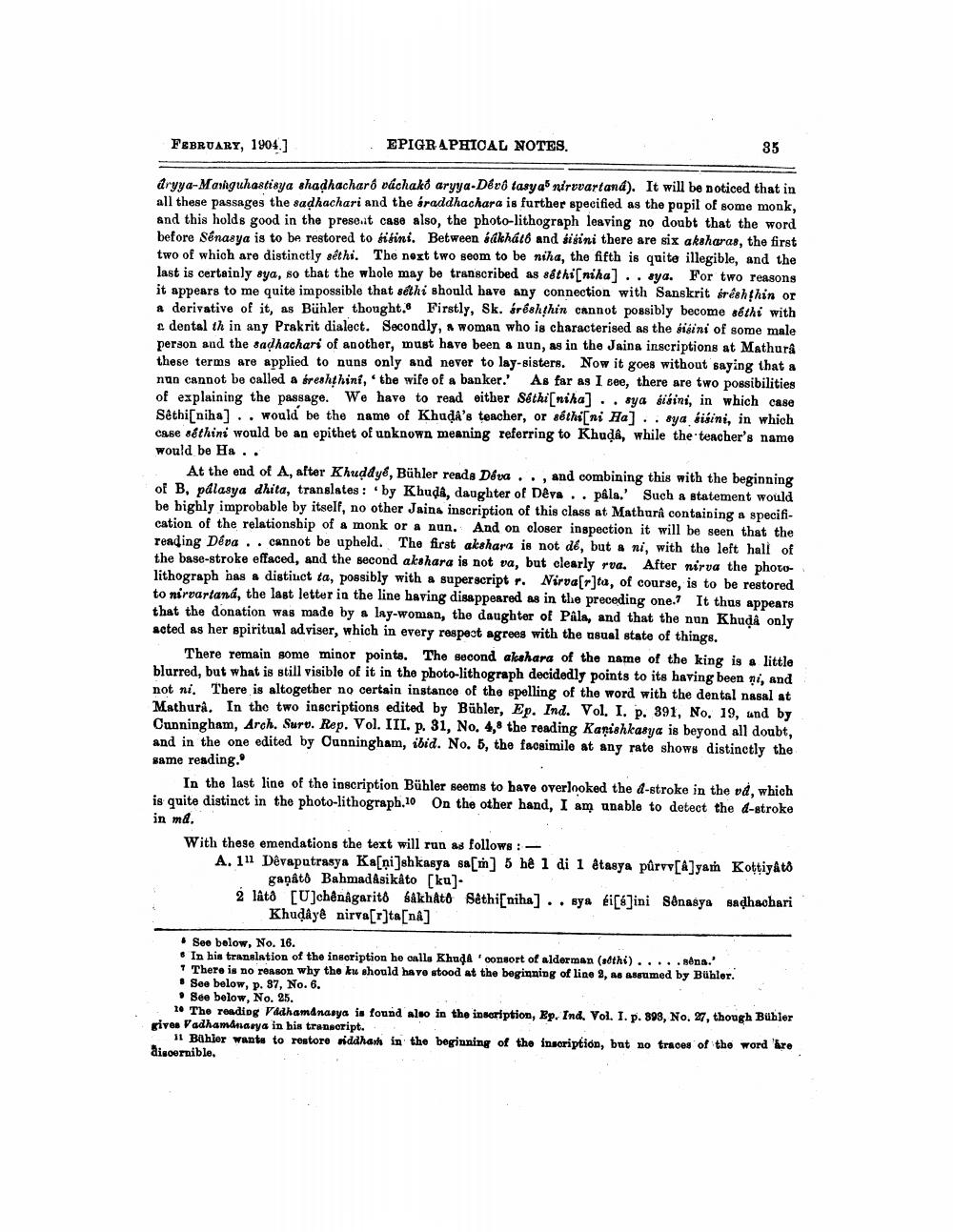________________
FEBRUARY, 1904.)
EPIGRAPHICAL NOTES.
35
dryya-Mariguhastisya shadhacharó váchako aryya-Dévô tasya nirvvartand). It will be noticed that in all these passages the sadhachari and the Sraddhachara is further specified as the papil of some monk, and this holds good in the present case also, the photo-lithograph leaving no doubt that the word before Sénasya is to be restored to sisini. Between bakhát6 and sisini there are six aksharas, the first two of which are distinctly séthi. The next two seem to be niha, the fifth is quite illegible, and the last is certainly sya, so that the whole may be transcribed as sethi[niha] .. sya. For two reasons it appears to me quite impossible that sethi should have any connection with Sanskrit érêshthin or a derivative of it, as Bühler thought. Firstly, Sk. árshthin cannot possibly become sethi with
dental th in any Prakrit dialect. Secondly, * woman who is characterised as the sigini of some male person and the sadhachari of another, must have been a nun, as in the Jaina inscriptions at Mathura these terms are applied to nuns only and never to lay-sisters. Now it goes without saying that a non cannot be called a freshthini, the wife of a banker. As far as I see, there are two possibilities of explaining the passage. We have to read either Sethi[niha] .. sya bibini, in which case Sêthi[niha) .. would be the name of Khuda's teacher, or sethi[ni Ha] .. sya bisini, in which case sethini would be an epithet of unknown meaning referring to Khudê, while the teacher's name would be Ha..
At the end of A, after Khuddye, Bühler reads Déva .. , and combining this with the beginning of B, palasya dhita, translates: by Khuda, daughter of Deva .. pâla. Such a statement would be highly improbable by itself, no other Jaina inscription of this class at Mathura containing a specification of the relationship of a monk or a nun. And on closer inspection it will be seen that the reading Deva .. cannot be upheld. The first akshara is not de, but a ni, with the left hall of the base-stroke effaced, and the second akshara is not va, but clearly rua. After nirva the photolithograph has a distinct ta, possibly with a super script r. Nirva[r]ta, of course, is to be restored to nirvartand, the last letter in the line having disappeared as in the preceding one. It thus appears that the donation was made by a lay-woman, the daughter of Pala, and that the nun Khudå only acted as her spiritual adviser, which in every respect agrees with the usual state of things.
There remain some minor points. The second akshara of the name of the king is a little blurred, but what is still visible of it in the photo-lithograph decidedly points to its having been ni, and not ni. There is altogether no certain instance of the spelling of the word with the dental nasal at Mathura. In tho two inscriptions edited by Bühler, Ep. Ind. Vol. I. p. 891, No. 19, und by Cunningham, Arch. Suru. Rep. Vol. III. p. 31, No. 4,8 the reading Kanishkasya is beyond all doubt, and in the one edited by Cunningham, ibid. No. 5, the facsimile at any rate shows distinctly the same reading.
In the last line of the inscription Bühler seems to have overlooked the 4-stroke in the vd, which is quite distinct in the photo-lithograph.10 On the other hand, I am unable to detect the d-stroke in ma. With these emendations the text will run as follows: A. 111 Dévaputrasya Ka[ni]shkasya sa[m] 5 hê 1 di 1 êtasya pûrvv[A]yam Kottiyâto
gapat) BahmadAsikáto [ku). lat Uchênagarito bakhato Séthi[niha] .. sya ki[b]ini Sônasya sadhachari
Khudayê nirva[r]ta[na]
. See below, No. 16. • In bin translation of the insoription he calls Khuda consort of alderman (althi).....ana.' * There is no reason why the ku should have stood at the beginning of line 2, as assumed by Bühler. • See below, p. 37, No. 6. . See below, No. 25.
2. The reading Vadhamdnasya is found also in the inscription, Ep. Ind. Vol. I. p. 893, No. 27, though Bühler gives Vadhamanarya in his transcript.
11 Buhler wants to restore viddhan in the beginning of the inscription, but no traces of the word 'kre discernible,




